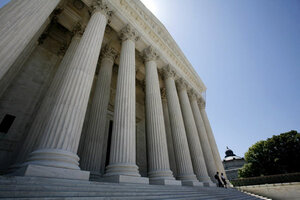No need for new eye witness rule, Supreme Court justices suggest at hearing
The Supreme Court heard oral arguments on whether judges need to intervene to prevent testimony from unreliable witnesses at criminal trials. The justices indicated that existing safeguards in the justice system are adequate.

During an hour-long oral argument session, several Supreme Court justices suggested that existing safeguards in the criminal justice system are adequate to prevent unreliable eyewitnesses from corrupting the process.
Molly Riley/Reuters
Washington
Members of the US Supreme Court appeared reluctant on Wednesday to establish a broad new constitutional rule to prevent unreliable eyewitness testimony at criminal trials.
During an hour-long oral argument session, several justices suggested that existing safeguards in the criminal justice system are adequate to prevent unreliable eyewitnesses from corrupting the process.
New Hampshire Public Defender Richard Guerriero argued that the court should establish a new standard in which judges would be instructed to exclude eyewitness testimony from a trial whenever the testimony posed a “substantial likelihood of misidentification.”
Justice Stephen Breyer noted that the rules of evidence already empower judges to make such determinations.
“What is the difference between what you are asking for and what already exists in the law,” Justice Breyer asked.
“What about all the other safeguards that you have,” Justice Ruth Bader Ginsburg said. “You can ask the judge to tell the jury: Be careful; eyewitness testimony is often unreliable. You can point that out in cross-examination.”
At issue in the case, Barion Perry v. New Hampshire, was whether state judges ruled properly when they allowed an eyewitness to testify at Mr. Perry’s trial even though the witness had been unable to identify Perry’s face in a police photo array.
Perry’s lawyers argued that the testimony was unreliable and should have been barred from the trial.
Prosecutors countered that under existing Supreme Court precedent, such testimony may be excluded from a trial only in instances where the police engaged in suggestive tactics that may have influenced and tainted the eyewitness’s observations. The courts found no manipulative tactics were used in Perry’s case.
Short of evidence of police misconduct, the justices have never before found that due process protections in the Constitution require a judge to assess a witness’s reliability. Instead, that determination is usually left to members of the jury at trial during direct and cross examination.
The case is being closely followed because it marks the first time since 1977 that the Supreme Court has considered the issue of witness reliability. In the 34 years since, a substantial body of research has established the acute danger posed by unreliable eyewitnesses.
Part of the danger lies in jurors’ desire to assign substantial weight to the observations of an eyewitness. But research has shown that eyewitness observations are often not as accurate as many believe – including the witness.
One study found that eyewitness misidentifications contributed to the wrongful convictions of 76 percent of the first 250 individuals who were exonerated by DNA testing since 1989.
Wednesday’s debate at the high court stems from the case against Perry for theft.
At 2:53 a.m. on Aug. 15, 2008, Nashua, N.H., police received a report that a black man was trying to gain entry into vehicles in an apartment building parking lot. The responding officer heard the sound of an aluminum bat falling to the pavement and discovered Perry in the lot between parked cars. He was carrying two sound system amplifiers.
Perry said he found the items and that two kids had been in the parking lot. The officer, Nicole Clay, was unable to locate any other suspects.
When a backup police officer arrived, Ms. Clay instructed Perry to remain with that officer in the parking lot.
She then entered the apartment building to question a witness, Nubia Blandon. Ms. Blandon spoke Spanish. A neighbor translated the questions and answers. Blandon told the officer that she had seen a tall, black man walk through the parking lot, looking into the cars, circle her neighbor’s car, open the trunk, and remove a large box. She said the man was carrying a baseball bat.
Officer Clay requested a description of the man. Blandon said it was the man in the back parking lot standing with the police officer. She gestured toward the window.
Blandon’s husband, Joffre Ullon, who phoned in the initial police report, told Clay he had seen a black man walking through the parking lot lifting up car door handles. The officer asked for a description of the man. Like his wife, Mr. Ullon said it was the man standing in the parking lot with the police officer.
In addition to the amplifiers, police found a large box with speakers in the parking lot.
Blandon reportedly watched Perry for more than a half hour before Officer Clay arrived, but she was unable to identify his face in a police photo array a month later. Ullon identified Perry’s photo when shown a police photo array.
Perry was arrested and charged with theft. Before the trial, his lawyer asked the judge to exclude Blandon’s out-of-court identification of Perry because the police presence in the parking lot made it suggestive and unreliable.
The judge ruled that the police had not engaged in a suggestive technique. The court further ruled that since the identification procedure was not suggestive, it was not necessary for the court to determine the reliability of Blandon’s statement. That issue would be left to the jury at Perry’s trial.
At trial, Perry was convicted and, because he had a prior record, was sentenced to three to 10 years in prison.
Perry’s lawyers appealed the suggestive witness issue. The New Hampshire Supreme Court dismissed the appeal and upheld the conviction.
They then appealed to the US Supreme Court.
A decision in the case is expected by June.
